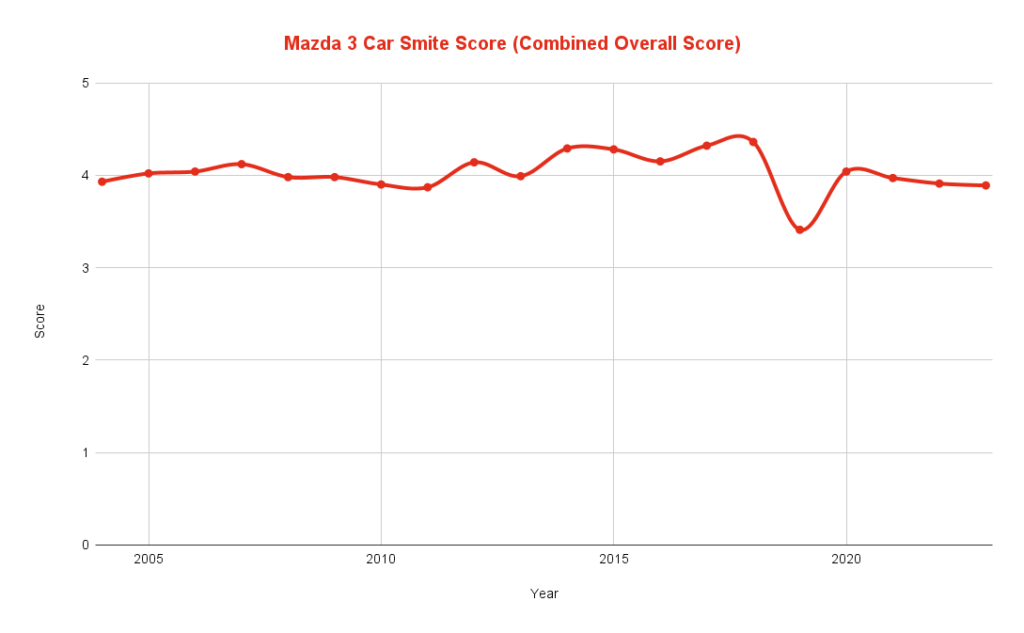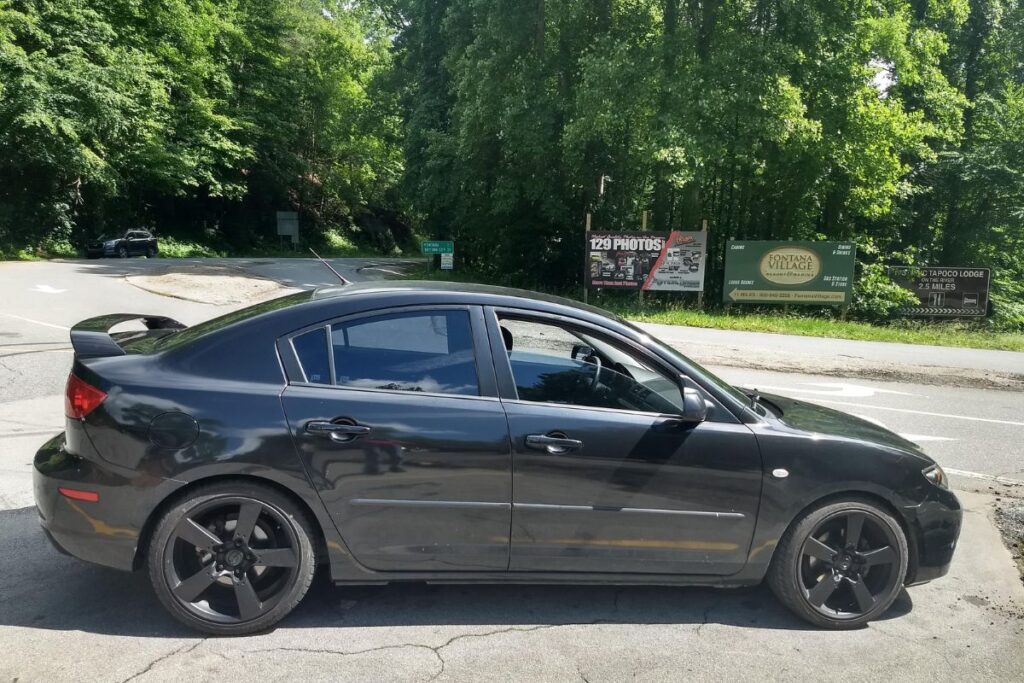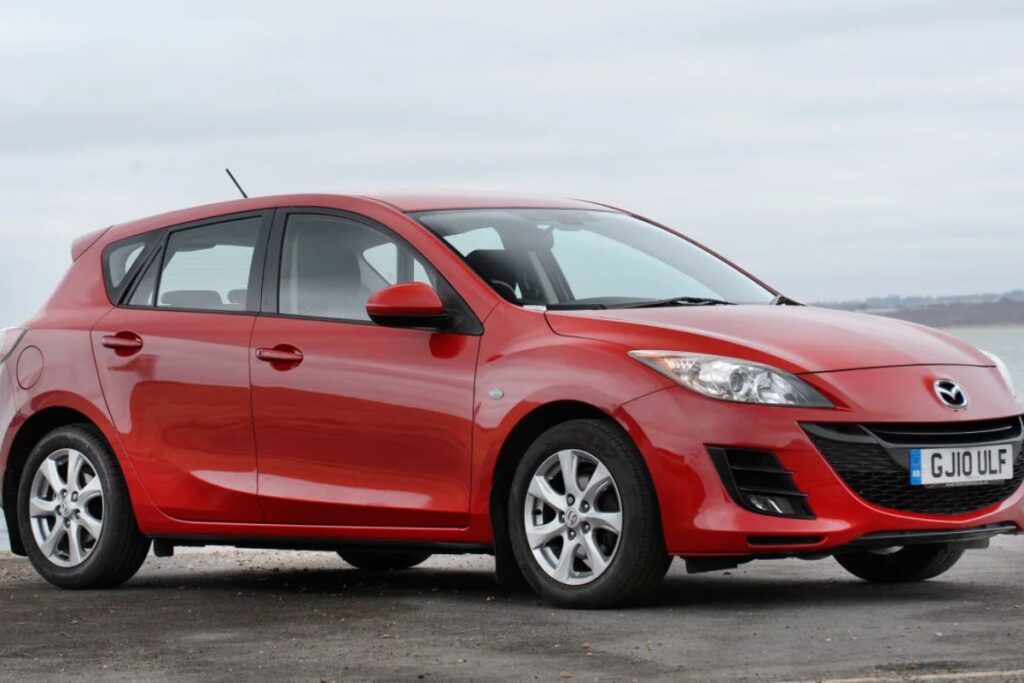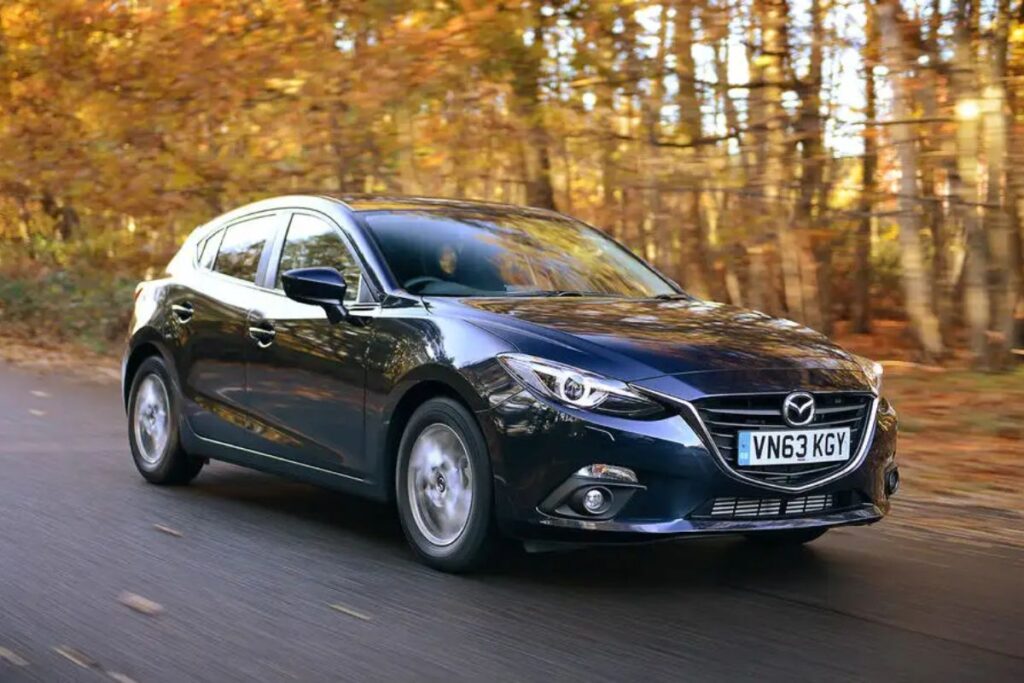Best and worst Mazda 3 years — which to avoid
I’ve reviewed every Mazda 3 from 2004 to the latest models. This guide highlights the best and worst years.
First, I’ll discuss each Mazda 3 generation. I’ll suggest good years to buy and years to avoid.
I used data from NHTSA, JD Power, and Consumer Reports. The guide details reliable and unreliable years.
You’ll learn about common issues, recalls, complaints, and resale values for each year. Let’s begin.
Mazda 3 Generations
The Mazda 3 first appeared in 2003 as a 2004 model. It quickly won praise for its design, performance, and features, even in the basic model.
It was available as both a sedan and hatchback, appealing to a wide range of drivers.
Now, let’s present a table to summarize each Mazda 3 generation from 2004 to today.
| Generations | Years |
| 1st generation (BK) | 2004-2009 |
| 2nd generation (BL) | 2010-2013 |
| 3rd generation (BM/BN) | 2014-2018 |
| 4th generation (BP) | 2019-Present |
Understanding these stages is crucial. It will help you make an informed decision. This is especially true because each model year added variations, upgrades, and improvements.
Mazda 3 Best, Neutral, and Worst Years
We rank and categorize the best, neutral, and worst years of the Mazda 3. Our analysis is thorough. It considers many factors, including:
- Owner-reported reliability (surveys)
- Annual maintenance costs
- Safety ratings
- Consumer Reports reliability scores
- Consumer Reports owner satisfaction scores
- NHTSA recalls, investigations, and complaints
- Edmunds owner ratings
- JD Power owner ratings
- Kelley Blue Book (KBB) owner ratings
- VehicleHistory owner ratings
- Cars.com owner ratings
The graph will show the ratings from the sources.

Then, the data will classify each Mazda 3 year as ‘best,’ ‘neutral,’ or ‘worst.’
| Generation | Best Years | Neutral Years | Worst Years |
|---|---|---|---|
| 1st generation (BK) | 2008 2009 | 2007 | 2004 2005 2006 |
| 2nd generation (BL) | 2012 2013 | N/A | 2010 2011 |
| 3rd generation (BM/BN) | 2017 2018 | 2016 | 2014 2015 |
| 4th generation (BP) | 2021 2022 2023 | 2020 | 2019 |
“Neutral Years” are model years that neither excelled nor failed significantly in our tests.
NHTSA recalls can lower a car’s reliability score. More complaints, recalls, and safety investigations signal issues. This reduces reliability and consumer trust.
Now, let’s review the best, neutral, and worst Mazda 3 model years.
Best & Worst Years for Mazda 3 1st Generation (2004-2009)

In 2003, Mazda introduced the world to the first Mazda 3. It was a compact car line that would soon win praise for its blend of pretty design, fun driving, and good fuel efficiency.
The Best Years: 2008, 2009
The post-facelift years of this generation—2008 and 2009—are considered the best Mazda 3 years. These models achieved relatively higher Consumer Reports reliability and owner satisfaction scores.
- 2008 Mazda 3: Introduced the “s” Sport trim with a 2.3L MZR L engine. It gives 156 horsepower and 150 lb-ft of torque. You could pair this engine with a five-speed manual or automatic transmission. Fuel economy was rated at 17 mpg city and 35 mpg highway. Some owners reported issues with the tire pressure system and valve stem leaks, which could cause flat tires. Yet, the model years stood out for their advanced audio system and safety features, including airbags. This led to high driver satisfaction and reliability.
The Neutral Year: 2007
The 2007 Mazda 3 had great features and powertrain options. But, it faced persistent issues.
- 2007 Mazda 3: The 2007 Mazda 3 had two engine options: a 2.0L and a 2.3L. The 2.0L engine produced 148 horsepower and 135 lb-ft of torque, while the 2.3L engine boasted 156 horsepower and 150 lb-ft of torque. This model, available in “i” and “s” versions, was popular for its performance in the compact car class. It offered a choice of a five-speed manual or a four-speed automatic transmission. However, it faced a significant issue with power steering. This flaw caused a recall due to the risk of losing power steering support.
The Worst Years: 2004, 2005, 2006
The pre-facelift years—2004, 2005, and 2006—are the least reliable Mazda 3 years to avoid.
- 2004 Mazda 3: The car had airbag issues. Sometimes, they failed to deploy in crashes. It also had significant engine problems. These included stalling and oil leaks from the filter housing. These issues caused mechanical problems and safety hazards.
- 2005 and 2006 Mazda 3: These models kept facing the same problems as the 2004 model. Specifically, the 2006 model experienced power steering and suspension issues. This significantly reduced the driving quality.
For detailed information, see the NHTSA recalls and complaints for the 2004, 2005, and 2006 Mazda 3 models.
Best & Worst Years for Mazda 3 2nd Generation (2010-2013)

The second generation of the Mazda 3 spanned from 2010 to 2013. It marked a time of better design and improved technology and mechanics for this beloved compact car.
The Best Years: 2012, 2013
The 2012 and 2013 Mazda 3 models are the best of this generation. This is thanks to the introduction of SkyActiv technology. They have great gas mileage and high Consumer Reports scores for reliability and owner satisfaction.
- SkyActiv Technology: Both years featured a 2.0L SkyActiv-G engine. It had 155 horsepower and 148 lb-ft of torque. It greatly improved fuel efficiency (up to 28 mpg city and 40 mpg highway) without hurting the Mazda 3’s great driving feel.
- Transmission Options: It is offered with a 6-speed manual and a 6-speed automatic transmission. Both use SkyActiv technology and ensure quick and smooth shifting.
- Interior Enhancements: In recent years, the car’s tech interface and navigation improved. In 2013, a USB port became standard on all models. Also, the cabin now offers better materials and some trims feature a 265-watt Bose Centerpoint surround-sound system.
- Reported Issues: Some owners noted premature clutch failures and minor electrical glitches in the infotainment system, but these issues were not widespread.
The Worst Years: 2010, 2011
The 2010 and 2011 Mazda 3 models are to be avoided due to prevalent dashboard and tire inflation valve stem issues.
- 2010 Mazda 3: The model had a melting dashboard issue. Its material degraded, leaving a shiny, sticky residue. This affected visibility and driving. Consequently, a class-action lawsuit was launched. Moreover, the 2010 model had motor mount issues and problematic seats. These components were later recalled.
- 2011 Mazda 3: The car kept its 2010 design and features. But, it still faced issues. Users complained about valve stems. They often caused tire deflation. Also, the dashboard problems continued. For details, see the NHTSA recalls and complaints for the 2010 and 2011 Mazda 3 models.
Best & Worst Years for Mazda 3 3rd Generation (2014-2018)

Navigating the journey of the Mazda 3. The third generation emerged with notable advances in design and technology.
The Best Years: 2017, 2018
What are the best years of used Mazda 3 to buy? The 2017 and 2018 models stand out as the best years of this generation. They have top reliability and owner satisfaction scores on VehicleHistory, Cars.com, and Consumer Reports. They also have far fewer owner complaints.
- Powertrains: These years saw Mazda offering 2.0L and 2.5L SkyActiv-G petrol engines. The 2.5L engine delivered 184 horsepower and 185 lb-ft of torque. It came with either a 6-speed manual or a 6-speed automatic transmission. Meanwhile, the 2.0L engine offered 155 horsepower and 150 lb-ft of torque. It achieved around 28 mpg in the city and 37 mpg on the highway in fuel efficiency.
- Safety and Technology: The Smart City Brake Support system now comes standard. It helps drivers avoid low-speed frontal collisions. Also, Mazda introduced G-Vectoring Control technology. This innovation improves steering by adjusting engine torque. It promises a smoother ride.
- Owner Feedback: Some owners noted issues. These included uncomfortable seats during long rides and some noise in the cabin. But, these issues were minor.The Neutral Year: 2016
The 2016 Mazda 3 presents a balanced perspective, with commendations and criticisms distributed relatively evenly.
- Features: This year’s model kept the same engines as the 2017 and 2018 models. But, it lacked their advanced tech and safety upgrades. Yet, it added more standard features across all trims, including a rearview camera and a touchscreen.
- Recalls and Issues: Some recalls impacted this model year. They were for issues like fuel leaks. The leaks came from a possibly defective Inlet Check Valve (ICV). They were also for worries about parking brake actuator corrosion.
The Worst Years: 2014, 2015
The 2014 and 2015 models are the Mazda 3 years to avoid in this generation. They got lower scores on Edmunds and J.D. Power, and owners reported brake problems.
- Common Issues: Owners reported fuel leaks and brake issues due to corrosion. Recalls were issued for models with the 2.5L engine and regenerative braking. This addressed concerns like sudden engine stalling and power steering loss.
- Recalls: Significant recalls focused on two key problems. Firstly, the fuel tank’s ICV could fail, leading to leaks. Secondly, parking brake actuators were prone to corrosion. These issues seriously hurt reliability. For details, see the NHTSA recalls and complaints for the 2014, 2015, and 2016 Mazda 3 models.
Best & Worst Years for Mazda 3 4th Generation (2019-Present)
The fourth generation of the Mazda 3 marked a new era. It took big steps toward luxury with a more premium look.
The Best Years: 2021, 2022, 2023
The Mazda 3 has strong performance and a good design. The 2021, 2022, and 2023 models are the best in this generation. They have better technology and safety features.
- Powertrain Options: In recent years, powertrain options expanded. There’s the standard 2.0L 4-cylinder engine. Also, the 2.5L Skyactiv-G PY-VPS 4-cylinder was added. Then, the 2.5L turbocharged 4-cylinder engine came in. It offers 250 horsepower and 320 lb-ft of torque. This is with a 6-speed automatic transmission. Moreover, the car’s fuel efficiency improved to 28 mpg in the city and 37 on the highway.
- Safety Features: The i-Activsense safety suite offered many driver-assistance features. These include adaptive cruise control, automated emergency braking, and lane-departure warning with lane-keeping assist.
- Recognition: The 2022 Mazda3 received a Top Safety Pick+ award from the IIHS.
- Owner Feedback: Some owners reported issues with the 2021 Mazda 3 using too much oil. But, overall, people think highly of these years.
The Neutral Year: 2020
In 2020, the Mazda 3 showed the brand’s commitment to performance and style. But, it ended up in a neutral spot in the car world.
- Powertrain: This model continued to offer the 2.5L 4-cylinder engine. It provided ample performance and fuel efficiency.
- Recalls: Recalls were common in this model year. They addressed issues like front brake caliper bolts that may loosen and fall off and intermittent activation of emergency brakes.
The Worst Year: 2019
It has the lowest Consumer Reports reliability and owner satisfaction scores. It also has numerous NHTSA recalls. 2019 is undoubtedly the Mazda 3 to avoid in this generation.
- Issues: Consumers reported concerns about powertrain issues. They also reported problems with brakes and airbag and seatbelt indicators.
- Recalls: This year had a series of recalls. They tackled issues like a software error. It could stall the engine. Also, there were unexpected activations of the emergency braking system. Plus, problems with rearview mirrors and wheel lug nuts.
The vehicle was hard for its owners. It had good driving dynamics and a sleek design. But, it also faced many recalls and issues. For more details, check the NHTSA recalls and complaints for 2019 and 2020 Mazda 3s.
Conclusion
We’ve examined the best Mazda 3 years. Notably, the 2013, 2017, 2018, and 2021-2023 models excel in performance and reliability.
When choosing a year, preferences vary. Some seek reliability, ensuring minimal issues over time. Others aim for high resale value, protecting their investment. Meanwhile, tech features attract those keen on innovation.
Ultimately, the choice depends on personal priorities. Is it reliability, resale value, or technology? What’s your preference? Share in the comments!




